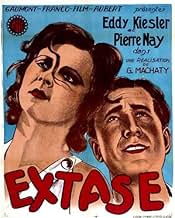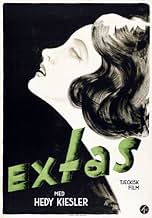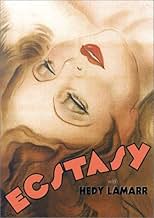AVALIAÇÃO DA IMDb
6,6/10
3 mil
SUA AVALIAÇÃO
Adicionar um enredo no seu idiomaEva has just got married to an older gentleman. She leaves him, and one day, she meets a young man, and they fall in love. Fate brings the husband together with the young lover that has take... Ler tudoEva has just got married to an older gentleman. She leaves him, and one day, she meets a young man, and they fall in love. Fate brings the husband together with the young lover that has taken Eva from him.Eva has just got married to an older gentleman. She leaves him, and one day, she meets a young man, and they fall in love. Fate brings the husband together with the young lover that has taken Eva from him.
- Direção
- Roteiristas
- Artistas
- Prêmios
- 2 vitórias e 1 indicação no total
Hedy Lamarr
- Eva Hermann
- (as Hedy Kiesler)
Emil Jerman
- Eva's husband
- (narração)
Antonín Kubový
- Landarbeiter
- (as Antonin Kibový)
Bedrich Vrbský
- Eva's father
- (narração)
Jirina Stepnicková
- Eva
- (narração)
Ladislav Bohác
- Adam
- (não creditado)
Comedian Harmonists
- Themselves
- (não creditado)
Kani Kipçak
- Dr. Brady
- (não creditado)
Karel Macha-Kuca
- Der Rechtsanwalt
- (não creditado)
Jirina Steimarová
- Typist
- (não creditado)
Avaliações em destaque
This early German talkie stars the gorgeous Hedy Lamarr as a bored hausfrau and is notorious for not only showing her in her birthday suit but also in the throes of passion. The film was banned in the US! For that reason alone, one should watch it. Lamarr is truly beautiful and offers a strong performance as the woman who falls for the security of an older man (and marries him) only to become restless and subsequently enthralled with a younger, more exciting lover.
This was a very daring film for it's day. It could even be described as soft-core porn for the silent era. It was a talkie, but dialog was extremely limited, and in German. One did not need it anyway.
The young (19) Hedy Lamarr gets trapped in a loveless marriage to an obsessive (stereotype?) German and after a short time in a marriage that was apparently never consummated, returns home to her father.
In a famous and funny scene, she decides to go skinny dipping one morning when her horse is distracted by another. She is then forced to run across a field chasing after it, as she left her clothing on the horse. An engineer retrieves her horse and returns her clothing - after getting an eyeful.
They sit for a while and, in a zen moment, he presents her with a flower with a bee sitting on top. This is where she thinks back to her honeymoon and the actions of her husband and an insect. She knows this man is different.
She returns home and eventually seeks out our young fellow, and finds the ecstasy she was denied. You can use your imagine here, but his head disappears from view and we see her writhing with pleasure. Since he never got undressed, you can imagine... Certainly, an homage to women by the director Gustav Machatý, and a shock to 1933 audiences.
The only thing that mars this beautifully filmed movie is the excessive guilt, and a strange ending.
The young (19) Hedy Lamarr gets trapped in a loveless marriage to an obsessive (stereotype?) German and after a short time in a marriage that was apparently never consummated, returns home to her father.
In a famous and funny scene, she decides to go skinny dipping one morning when her horse is distracted by another. She is then forced to run across a field chasing after it, as she left her clothing on the horse. An engineer retrieves her horse and returns her clothing - after getting an eyeful.
They sit for a while and, in a zen moment, he presents her with a flower with a bee sitting on top. This is where she thinks back to her honeymoon and the actions of her husband and an insect. She knows this man is different.
She returns home and eventually seeks out our young fellow, and finds the ecstasy she was denied. You can use your imagine here, but his head disappears from view and we see her writhing with pleasure. Since he never got undressed, you can imagine... Certainly, an homage to women by the director Gustav Machatý, and a shock to 1933 audiences.
The only thing that mars this beautifully filmed movie is the excessive guilt, and a strange ending.
There's no entertainment value in this confusing montage fest. There's a love triangle melodrama wrapped inside, but it's not worth the price of admission. I suspect the film is dripping with all sorts of symbolism, but what it says is never entirely clear. We get shots of flowers, horses, pick axes, and flies, flies, flies. The artsy montages interrupt the story whenever possible and go on and on, overstaying their welcome after delivering their messages.
This practically silent Czech-made movie is notable today for its nude and erotic scenes with Hedy Lamarr, years before she became a star in Hollywood. The scenes, tastefully done, really pushed the envelope back in the early 1930s, giving this film some historical significance.
It boggles my mind to see so many rave reviews for this film. Sure, it has its claims to cinematic history, but this is not a very good film. It is way too drawn out, weighed down by heavy-handed symbolism, and ultimately unsatisfying. A footnote in a textbook, sure, but no masterpiece.
Perhaps one must possess a certain artistic mind to fully appreciate this film's "poetry". If that is the case, I guess I just don't have it.
Not worth your time except as a curiosity for the rabid cinephile.
This practically silent Czech-made movie is notable today for its nude and erotic scenes with Hedy Lamarr, years before she became a star in Hollywood. The scenes, tastefully done, really pushed the envelope back in the early 1930s, giving this film some historical significance.
It boggles my mind to see so many rave reviews for this film. Sure, it has its claims to cinematic history, but this is not a very good film. It is way too drawn out, weighed down by heavy-handed symbolism, and ultimately unsatisfying. A footnote in a textbook, sure, but no masterpiece.
Perhaps one must possess a certain artistic mind to fully appreciate this film's "poetry". If that is the case, I guess I just don't have it.
Not worth your time except as a curiosity for the rabid cinephile.
Dripping with symbolism and filled with marvelous cinematography, Extase is so much more than the erotic drama we've all come to expect. This is almost a silent film, with what dialogue there is in German, and highly simplified German at that. Perhaps the filmmakers intended the film to reach the widest possible European audience, as anyone with even a little high school level Deutsch can easily dispense with the subtitles. The story is of little importance anyway, with the film succeeding on a cinematic level, not a narrative one. Symbols of fecundity and the power of nature overwhelm the human characters--there are even scenes where flowers obscure the face of supposed star Hedy Lamarr--and there are moments here that will remind viewers of the works of Dreyer, Vertov, and Riefenstahl. If the film has any message to convey, I think it's a political one: bourgeois man is timid and impotent; working class man is a happy, productive creature; and woman is the creator, destined to be unfulfilled until she has borne a child. This blend of Soviet socialist realism and National Socialist dogma doesn't overwhelm the film by any means--it's a beauty to watch from beginning to end--but it does place it in a very distinct artistic era. And, oh yeah, Hedy does get her kit off.
This is one that sent church and censors in disarray when it made its way to America, no doubt for the divorced woman who runs fully naked through the woods. The things people would be so uptight about, so tame to us now. But it introduced Lamarr to Hollywood.
A young woman then who yearns to be open to sense things, live life, but she's stifled by thankless marriage. The whole plot is typical, what they were calling kammerspiel in Germany, about the twists and turns of love, until the moral denouement that inevitably parts lovers.
But instead of narrowing down to a room and stage, it opens up sense to things, we have a poetry of evocative skies, nature, reflections, glances of the eye that conjoin a wider world. In many respects it might as well have been a silent, dialogue is scant.
And it does more than paint in fact, it paints the state of mind that gives rise to the pulls that create narrative. You'll see this in the famous scene mentioned above, where capricious horse nature sends her out to meet her mate. Or the marvelous scene later that night of anxiously being unsure if she wants to go to his house, rendered with wind through an empty house and dark rolling skies above.
It's simple in contrasts and goes down rather easy but dressed and timed to resonate. The ex husband languishing in an empty room while the lovers are greeted with music in the tavern next door. Love isn't allowed last say however as if that would be too upsetting for the social norm.
But something else is, more poignant eventually.
The ending shows a working site with tools strewn about, deserted at morning. But does life stop in its tracks because a woman left? We now see workers file in and joyously go to work, the work of doing is resumed with song, the ground transformed, a faucet turned on and waters of life pour freely. It's the most vital scene in the film, emulating the Soviet filmmakers but so good it's worthy of being in Zemlya.
A young woman then who yearns to be open to sense things, live life, but she's stifled by thankless marriage. The whole plot is typical, what they were calling kammerspiel in Germany, about the twists and turns of love, until the moral denouement that inevitably parts lovers.
But instead of narrowing down to a room and stage, it opens up sense to things, we have a poetry of evocative skies, nature, reflections, glances of the eye that conjoin a wider world. In many respects it might as well have been a silent, dialogue is scant.
And it does more than paint in fact, it paints the state of mind that gives rise to the pulls that create narrative. You'll see this in the famous scene mentioned above, where capricious horse nature sends her out to meet her mate. Or the marvelous scene later that night of anxiously being unsure if she wants to go to his house, rendered with wind through an empty house and dark rolling skies above.
It's simple in contrasts and goes down rather easy but dressed and timed to resonate. The ex husband languishing in an empty room while the lovers are greeted with music in the tavern next door. Love isn't allowed last say however as if that would be too upsetting for the social norm.
But something else is, more poignant eventually.
The ending shows a working site with tools strewn about, deserted at morning. But does life stop in its tracks because a woman left? We now see workers file in and joyously go to work, the work of doing is resumed with song, the ground transformed, a faucet turned on and waters of life pour freely. It's the most vital scene in the film, emulating the Soviet filmmakers but so good it's worthy of being in Zemlya.
Você sabia?
- CuriosidadesFirst surviving non-pornographic film to depict a woman having an orgasm.
- Erros de gravaçãoIn the beginning when Emil is in the bedroom, a closeup of the photo on the bedside table is shown to have writing on it. On the second closeup, when Emil is carefully rearranging his keys and other items, there is no writing.
- Citações
Eva Hermann: Tell him... no. Don't tell him anything.
- Versões alternativasTo get the film around the more conservative German censors, an alternate version of Hedy Lamarr's nude bathing scenes was shot in which she was partially obscured by strategically-placed bushes.
- ConexõesEdited into Histoire(s) du cinéma: Fatale beauté (1994)
Principais escolhas
Faça login para avaliar e ver a lista de recomendações personalizadas
- How long is Ecstasy?Fornecido pela Alexa
Detalhes
- Tempo de duração
- 1 h 22 min(82 min)
- Cor
- Mixagem de som
- Proporção
- 1.19 : 1
Contribua para esta página
Sugerir uma alteração ou adicionar conteúdo ausente































